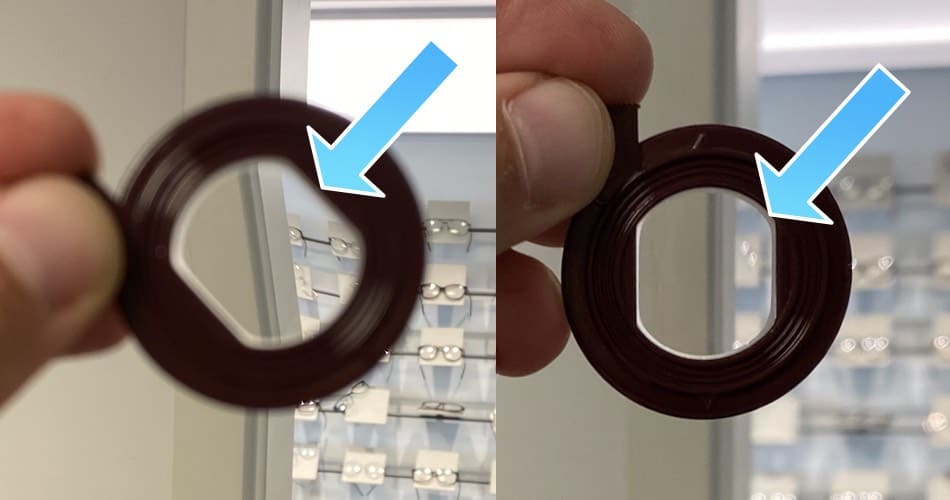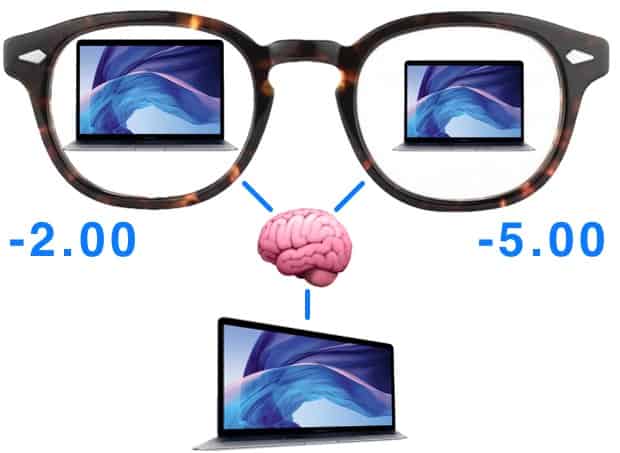If you experience things looking slanted with your glasses and you want to know why. You are in the right place. Here you will see why this happens and what you could do about it to minimize this effect.
When things look slanted the cause comes from the prescription for each eye or from the information your brain receives from both eyes playing together.

Astigmatism in your prescription and what it has to do with a slanted perception?
Oftentimes when the astigmatism is corrected for the first time or if astigmatism changed in the new prescription. Astigmatism in general deviates the light in two oppositely laying directions more compared to the remaining two directions.
This can give you a perception of everything looks squeezed a bit. Somehow taller or thicker and smaller. However, this only is true if astigmatism is positioned horizontally or vertically.
But oftentimes astigmatisms need to be placed in an oblique position to correct the person perfectly. This leads to a perfectly clear image. However, your brain perceived a certain object before you have got your new prescription as straight. And all of a sudden the new glasses shift and squeeze the image into another position.

Then your brain will need some time to learn again what once was straight and upright is still upright and straight with the new prescription. Usually, this takes a few days until a couple of weeks. Depending on how severe your needed change in lens power is.
You can fight this effect with the following two options:
- Contact lenses
- Atoric lens designs
The closer the lenses get to your eye the lesser you will perceive things in a slanted way. However, with eyeglasses, this effect can only go away after time when your brain adjusts to the new visual experience.
With contact lenses, you will not have to bother with this effect. There is less time needed to adapt to contact lenses and how you see the world. Adaption happens often almost in no time with contacts.
If contact lenses are not an option and you do want to have the shortest time for the adaption period it makes sense to use atoric lenses. They have an optimization that improves the visual experience in the periphery. Especially when you want to buy a bigger frame in combination with higher astigmatism of 2 diopters or more this makes sense.
Different Lens Powers for Each Eye and the Problem When Things Look Slanted
In the first paragraphs, we talked about astigmatism and how it can change the way how you perceive things. Astigmatism gets measured for each eye individually. However, in the real world, both eyes need to work together optimally to give you a perception of depth.
But what happens when the prescription is vastly different from the right eye to the left eye? In such a case each eye receives the light in the back of the eye in a slightly another way. This leads to slightly different sizes of the picture in the back of each eye.

As both images get fused together in the visual cortex in your brain the result will be straight lines look slanted. Like if you look at a TV it looks smaller on one side compared to the other.
This effect as the one described before will go away over time when your brain adapts to the new visual experience. This can take a few hours up to a few weeks. This depends on how fast you can adapt and how big the difference in prescription is between your eyes needs to be.
In some cases, people can not adapt to the big difference between both eyes. The solution here would be contact lenses. As stated before atoric lenses in the glasses or also aspheric lenses can minimize this effect a little but it will not go away with glasses. The time to adapt can be a little reduced.
But only when your brain gets used to the two different sizes of the pictures it perceives things will go back to a normal shape.
If you experience this slated visual effect a second appointment should be made with your eye care professional to see how your eyes play together. Because in some cases if the brain can not fuse the pictures from both eyes it suppresses one eye and favors the other.
If this happens your perception of depth will suffer. This should be checked in the following days and weeks after you received your new glasses to prevent suppression.
Conclusion
It is always a good thing to speak about what you experience with your new glasses or contact lenses. Only when the professional knows he can react and can improve things for you. So do not hesitate to tell the optician, optometrist, or ophthalmologist about your glasses making things look slanted.
He will then observe and check what next step would be best for you.
I wish you a great day.
